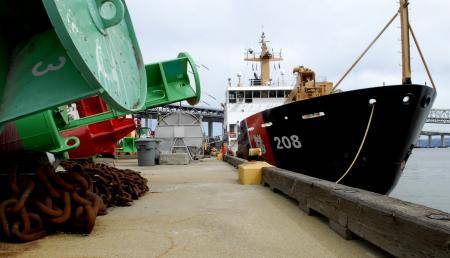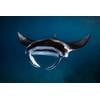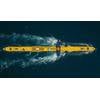USCG, NOAA Place Weather Buoy off California

Coast Guard Cutter Aspen is moored at Sector San Francisco on Yerba Buena Island, Calif., Monday, Aug. 26, 2013. The Aspen is a sea-going buoy tender responsible for more than 100 navigational aids from the California-Oregon border to San Diego. U.S. Coast Guard photo by Loumania Stewart
Coast Guard, NOAA work together to place weather buoy in Northern Calif. waters
The crew of the Coast Guard Cutter Aspen coordinated with the National Oceanic and Atmospheric Administration to replace a faulty weather buoy 25 miles off the coast of Half Moon Bay, Calif., Thursday.
Designated “3D69/46012”, the 3,500 pound, 18 feet high by 9 feet wide weather buoy is designed to measure wind speed, air and water temperatures, barometric pressure, and wave height and periods. The data, collected by sensors located on the inside and top of the buoy, is transmitted to the Stennis Space Center in Mississippi for publication on its website.
Earlier this year, the weather buoy had ceased transmitting weather data.
“Fishermen complained to local congressmen about the lack of information for weather conditions in the area,” said Lt. Cmdr. Dan Twomey, assigned to the waterways division at Coast Guard Island in Alameda, Calif. “The congressional inquiry to NOAA highlighted the importance of this particular weather buoy for the safety of mariners at sea.”
NOAA then coordinated with the Coast Guard's 11th District waterways division to schedule a time for the Aspen’s crew to conduct a hull “swap out,” replacing the older, nonfunctioning buoy with the newer one, said Twomey.
“There is a memorandum of agreement in place which allows the Coast Guard to assist the National Data Buoy Center (NDBC), which is part of the NOAA weather service, and when they need our help we are happy to assist,” said Twomey.
Unfortunately, the buoy could not be replaced until months later because of a lengthy process which included the construction of a new buoy, shipping it to the correct location and then scheduling a time with the Aspen. The Aspen’s operations team must then take into account the weather conditions and their availability.
“The Aspen’s crew capitalized on a brief break in the rough weather conditions and decided that Thursday morning was the ideal time for safe servicing,” said Capt. Tom D’Arcy, commanding officer aboard the Aspen.
The Aspen’s crew based their decision on weather information obtained from the nearest NOAA buoy, located approximately 40 miles to the north, as well as radio weather broadcasts and online weather information, said Twomey.
“The crew spent approximately four hours conducting a hull swap out using technology aboard the Aspen to maintain our position and complete the mission,” said Petty Officer 2nd Class Peter Hernandez, an electrician’s mate aboard the Aspen.
Kenion Lewis, an electronics technician for the NDBC, said the Aspen’s crew “welcomed and took care of him.”
“The Coast Guard and NDBC partnership improves the availability of offshore weather information and the safety of mariners out at sea. The partnership results in fewer search and rescue cases while providing accurate on scene weather conditions for coordination efforts,” said Twomey.
U.S. Coast Guard Cutter Aspen is homeported in San Francisco and is one of the most technologically advanced cutters in the Coast Guard fleet. Its area of responsibility stretches from the Oregon-California border south to San Diego.
uscgnews.com














 August 2025
August 2025



